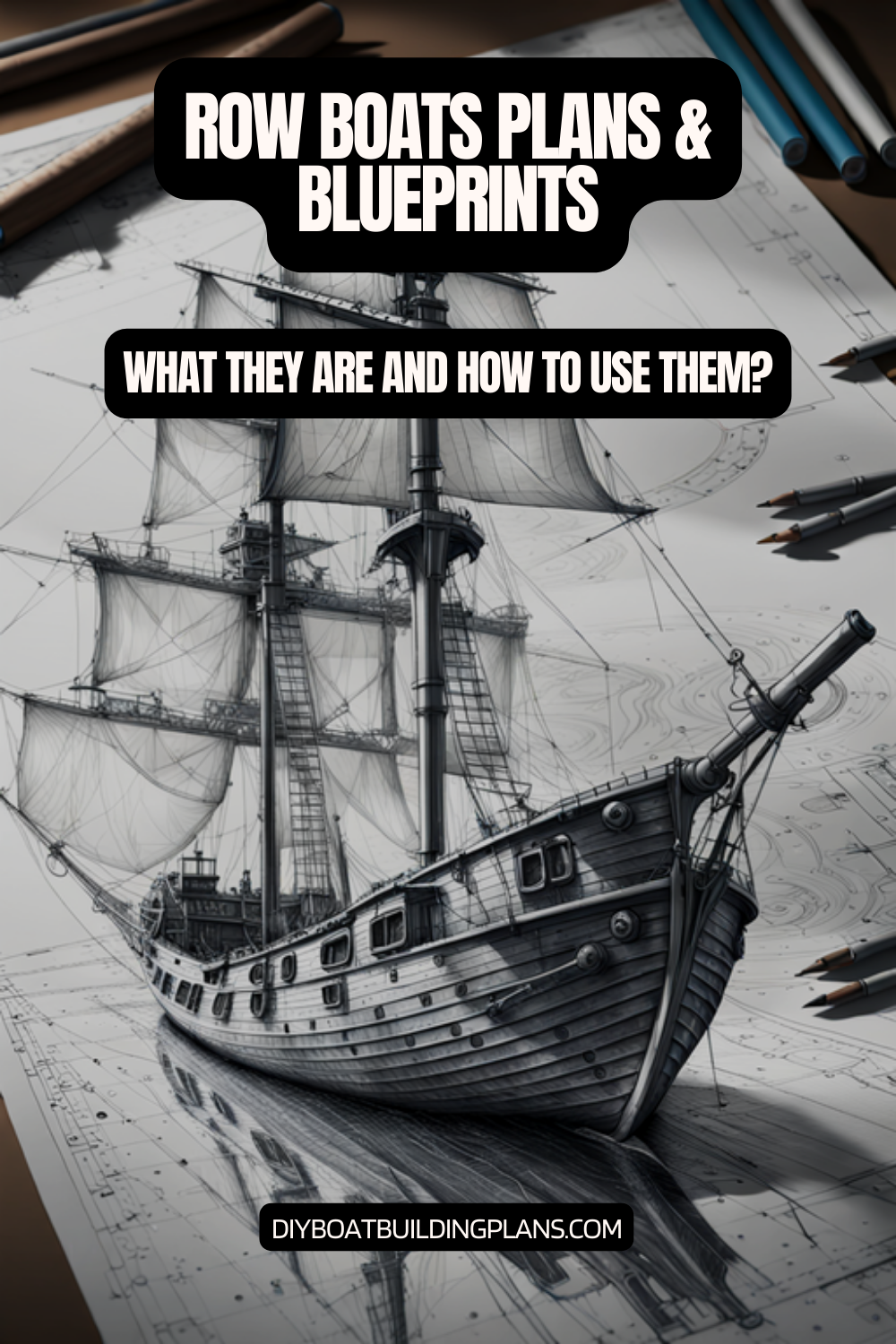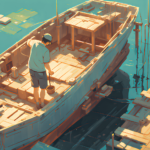Overview of Row Boat Plans & Blueprints
Building a row boat from scratch can be a rewarding and fulfilling experience for both experienced and aspiring boat enthusiasts. Having access to reliable row boat plans and blueprints is essential in ensuring the success of your project. These detailed guides not only provide the necessary technical information but also offer valuable insights into the fundamental principles of row boat design, construction, and maintenance.
The importance of having accurate and comprehensive row boat plans cannot be overstated. These plans serve as the foundation for your project, guiding you through every step of the building process and ensuring that your final product meets your specific requirements and expectations. By following well-designed plans, you can avoid common pitfalls, save time and resources, and ultimately create a row boat that is both functional and aesthetically pleasing.
In this article, we will explore the world of row boat plans and blueprints, delving into the benefits of building your own row boat, the key factors that influence design and performance, and the essential components of a comprehensive plan. We will also provide step-by-step guidance on constructing a row boat from scratch, troubleshooting common issues, and maintaining your handcrafted vessel for years to come.
Key Takeaways
- Row boat plans and blueprints are essential for building a handcrafted row boat.
- Understanding the basics of row boat design is crucial before choosing the right plans.
- Accurate measuring and scaling of row boat plans is necessary for a successful build.
- Building a row boat requires specific materials and tools, as well as following a step-by-step guide.
- Proper maintenance and care of your handcrafted row boat will ensure its longevity.

Understanding the Basics of Row Boat Design
The design of a row boat is a delicate balance of various factors, each playing a crucial role in the overall performance and stability of the vessel. Understanding the fundamental principles of row boat design is essential for selecting the right plans and ensuring a successful building project.
At the core of row boat design are the principles of hydrodynamics, which govern the interaction between the boat and the water. Factors such as the hull shape, waterline length, and displacement directly impact the boat’s speed, maneuverability, and stability. Designers must carefully consider these elements to create a row boat that glides effortlessly through the water, providing a smooth and efficient rowing experience.
Beyond the hydrodynamic considerations, row boat design also encompasses the structural integrity of the vessel. The choice of materials, construction methods, and reinforcement techniques all contribute to the overall strength and durability of the boat. Factors such as the type of wood, the thickness of the planking, and the placement of ribs and stringers can significantly affect the boat’s ability to withstand the stresses of rowing and the elements.
Exploring the diverse range of row boat designs available can provide valuable insights into the unique characteristics and performance capabilities of each type. From the sleek and agile racing shells to the sturdy and stable recreational row boats, each design offers its own set of advantages and trade-offs. Understanding these differences can help you make an informed decision when selecting the right plans for your project.
Choosing the Right Row Boat Plans for Your Needs
Selecting the appropriate row boat plans for your project is a crucial step in ensuring a successful and satisfying building experience. The choice of plans should be based on a careful consideration of your specific requirements, preferences, and the intended use of the row boat.
The first step in choosing the right plans is to identify your specific needs and preferences. Are you looking to build a row boat for recreational use, competitive racing, or a combination of both? Do you have any specific design features in mind, such as a particular hull shape or seating arrangement? Answering these questions will help you narrow down the available plan options and ensure that the final product meets your expectations.
Once you have a clear understanding of your requirements, it’s time to evaluate the various row boat plan options available. This may involve researching online resources, consulting with experienced boat builders, or even visiting local boat shows or workshops to get a firsthand look at different designs. Pay close attention to the level of detail, construction methods, and the overall quality of the plans, as these factors will directly impact the ease and success of your building project.
When selecting the most suitable plan, consider factors such as the complexity of the design, the availability of materials, and your own skill level and experience in boat building. While ambitious designs can be rewarding, it’s important to choose a plan that aligns with your abilities and resources to ensure a smooth and enjoyable building process.
Essential Components of a Row Boat Blueprint
A comprehensive row boat blueprint is the foundation for a successful building project, providing the necessary technical information and guidance to ensure a well-constructed and functional vessel. These detailed plans typically include a range of essential components that cover every aspect of the row boat’s design and construction.
At the heart of a row boat blueprint are the detailed technical drawings and schematics. These intricate illustrations provide a clear and accurate representation of the boat’s dimensions, shape, and structural components. From the overall hull design to the placement of ribs, stringers, and other reinforcements, these drawings serve as a roadmap for the entire building process.
Accompanying the technical drawings are the detailed specifications for the required materials, including the type and dimensions of the wood, fasteners, sealants, and other essential components. These specifications ensure that you have the right materials on hand and that they are used in the appropriate quantities and configurations.
In addition to the technical drawings and material specifications, a comprehensive row boat blueprint also includes step-by-step instructions and guidance for the construction process. These instructions cover everything from the initial layout and cutting of the wood components to the final assembly and finishing touches. By following these detailed instructions, even novice boat builders can navigate the building process with confidence and achieve a successful outcome.
Measuring and Scaling Row Boat Plans Accurately
| Plan Name | Price | Difficulty Level | Number of Pages | Materials List |
| Classic Wooden Rowboat Plans | 29.99 | Intermediate | 25 | Wood, screws, nails, epoxy, paint |
| Stitch and Glue Rowboat Plans | 39.99 | Advanced | 35 | Marine plywood, fiberglass, epoxy, paint |
| Flat Bottom Rowboat Plans | 19.99 | Beginner | 15 | Wood, screws, nails, paint |
Accurate measurements and scaling are critical components of a successful row boat building project. Inaccuracies in these areas can lead to significant problems during the construction process, resulting in a boat that may not fit together properly or perform as expected.
The importance of precise measurements cannot be overstated. From the overall dimensions of the hull to the placement of individual components, every measurement must be carefully taken and verified to ensure the final product matches the design specifications. This attention to detail is particularly crucial when working with plans that may need to be scaled up or down to fit your specific needs.
When scaling row boat plans, it is essential to employ techniques that maintain the integrity of the design. This may involve the use of specialized software, careful calculations, or even the creation of physical templates to ensure accurate scaling. By taking the time to properly scale the plans, you can be confident that the final dimensions of your row boat will be accurate and that the construction process will proceed smoothly.
Throughout the building process, it is crucial to continuously monitor and verify the accuracy of your measurements. This may involve the use of specialized tools, such as calipers and rulers, as well as regular cross-checks and comparisons to the original plans. By maintaining this level of attention to detail, you can minimize the risk of errors and ensure that your handcrafted row boat meets your expectations.
Materials and Tools Required for Building a Row Boat
Building a row boat from scratch requires a carefully curated selection of materials and tools to ensure a successful and efficient construction process. From the choice of wood to the specialized equipment needed for shaping and assembly, each component plays a vital role in the overall quality and durability of the final product.
The selection of the appropriate materials is a critical step in the row boat building process. Factors such as the type of wood, the thickness of the planking, and the choice of fasteners and sealants can significantly impact the boat’s performance, strength, and longevity. Carefully researching and sourcing the right materials, in accordance with the specifications outlined in the row boat plans, is essential for achieving a high-quality and reliable vessel.
In addition to the materials, the tools required for building a row boat can vary depending on the complexity of the design and the construction methods employed. From basic hand tools, such as saws, chisels, and clamps, to more specialized power tools for shaping and joining the wood components, the right tools can make the building process more efficient and precise. Ensuring that you have access to the necessary tools, and that you are comfortable using them, can greatly contribute to the success of your row boat building project.
Preparing the workspace and ensuring a safe working environment is also a crucial consideration. This may involve setting up a dedicated workspace, ensuring proper ventilation, and implementing safety protocols to protect yourself and your project during the construction process. By taking the time to properly organize your workspace and prioritize safety, you can minimize the risk of accidents and ensure a smooth and enjoyable building experience.
Step-by-Step Guide to Constructing a Row Boat from Plans
Constructing a row boat from scratch can be a rewarding and satisfying experience, but it requires a methodical approach and attention to detail. By following a comprehensive step-by-step guide based on the row boat plans, you can navigate the building process with confidence and achieve a successful outcome.
The first step in the construction process is to carefully lay out the plans and prepare the necessary materials. This involves thoroughly reviewing the technical drawings, verifying the material specifications, and ensuring that you have all the required components on hand. Taking the time to organize your workspace and materials can greatly streamline the building process and minimize the risk of delays or errors.
Next, you will begin the process of cutting and shaping the wood components that will form the frame and hull of the row boat. This may involve the use of specialized tools, such as saws, planers, and routers, to ensure precise and consistent cuts. As you work through this stage, it is crucial to continuously refer to the plans and measurements to ensure that the individual pieces fit together seamlessly.
With the frame and hull components prepared, the next step is the assembly of the row boat. This process typically involves the careful placement and joining of the various structural elements, such as the ribs, stringers, and planking. Depending on the design, this may also include the installation of additional features, such as the oarlocks, seats, and any decorative elements.
As the construction nears completion, the final touches, such as sanding, finishing, and the application of sealants and paints, will be crucial in ensuring the long-term durability and aesthetic appeal of your handcrafted row boat. By following the detailed instructions and guidance provided in the plans, you can ensure that your row boat not only meets your expectations but also stands the test of time.
Troubleshooting Common Issues in Row Boat Building
Building a row boat from scratch can be a rewarding experience, but it is not without its challenges. Throughout the construction process, you may encounter various issues that require troubleshooting and problem-solving skills. By being prepared to address these common challenges, you can navigate the building process with confidence and achieve a successful outcome.
One of the most common issues that row boat builders face is related to the materials used in the construction. This may include problems with the quality or suitability of the wood, the failure of fasteners, or issues with the application of sealants and finishes. By carefully following the material specifications outlined in the plans and seeking guidance from experienced builders or experts, you can often resolve these problems and ensure the structural integrity of your row boat.
Another common challenge is related to the construction techniques and methods employed during the building process. This may include difficulties in aligning the various components, achieving the desired hull shape, or ensuring the overall stability and balance of the boat. By closely following the step-by-step instructions in the plans and seeking guidance from resources such as instructional videos or workshops, you can often overcome these challenges and refine your building skills.
In some cases, the issues may be related to the accuracy of the plans or the scaling process. If you encounter discrepancies or unexpected problems during the construction, it is important to carefully review the plans, re-measure the components, and seek advice from experienced builders or the plan providers. By addressing these issues proactively, you can ensure that your row boat meets the design specifications and performs as expected.
Throughout the troubleshooting process, it is essential to maintain a problem-solving mindset, be patient, and be willing to experiment and learn from your experiences. By embracing the challenges and finding creative solutions, you can not only overcome the obstacles but also develop a deeper understanding and appreciation for the art of row boat building.
Maintaining and Caring for Your Handcrafted Row Boat
Owning a handcrafted row boat is a source of immense pride and joy, but it also requires proper care and maintenance to ensure its longevity and performance. By following a comprehensive maintenance regimen, you can prolong the lifespan of your vessel and continue to enjoy the thrill of rowing for years to come.
Proper storage and transportation of the row boat are crucial for preserving its condition. When not in use, the boat should be stored in a dry, well-ventilated environment, protected from the elements and potential damage. When transporting the boat, it is essential to use appropriate racks or trailers that support the hull and minimize the risk of scratches or deformation.
Routine maintenance and inspections are also essential for maintaining the health and performance of your row boat. This may include regular cleaning, checking for any signs of wear or damage, and addressing any issues promptly. Depending on the materials and construction methods used, you may need to apply protective coatings, such as varnish or sealants, to prevent weathering and ensure the boat’s structural integrity.
In addition to the physical maintenance of the row boat, it is also important to consider the proper care and storage of the oars, seats, and other accessories. These components play a crucial role in the overall functionality and comfort of the vessel, and they require similar attention to ensure their longevity.
By following a comprehensive maintenance plan and addressing any issues as they arise, you can ensure that your handcrafted row boat continues to provide you with years of enjoyment and reliable performance. Whether you’re an avid rower or simply appreciate the beauty and craftsmanship of a well-built boat, proper care and maintenance will be the key to preserving your investment and creating lasting memories on the water.

Conclusion – Row Boat Plans & Blueprints
Choosing a row boat plan and blueprint that aligns with your purpose, budget, and skill level is a crucial first step in embarking on the rewarding journey of building your own row boat. In this article, we’ve explored the significance of row boat plans and blueprints, delving into their role in saving time and money, ensuring quality and safety, and providing a platform for customization. Understanding the benefits of rowing and essential considerations before starting your project has equipped you with a comprehensive overview.
Download over 500 Boat Plans. Click on the link below.
-->Click Here<--
As you navigate the vast sea of row boat plans and blueprints, Part 2 has guided you on where to find them, emphasizing the diverse sources both online and offline. The discussion on free and paid options, along with the pros and cons, aids in making an informed decision. Armed with tips for acquiring high-quality plans and blueprints, you’re better equipped to ensure the success of your row boat project.
The transformative journey from plans to reality, explored in Part 3, takes you through the practical steps of transferring, cutting, shaping, and assembling. Safety precautions and guidelines, as well as the principles of row boat design and construction, underline the importance of precision and attention to detail. The final strokes of finishing and painting not only protect your creation but also add a touch of personalization and aesthetic appeal.
As you prepare to set sail on your rowing adventure, armed with the knowledge and guidance provided in this article, remember that building a row boat is not just about constructing a vessel; it’s about crafting memories, embracing a fulfilling hobby, and enjoying the therapeutic benefits of being out on the water. May your row boat project bring you joy, satisfaction, and countless moments of serenity on the open waves. Happy building!
FAQs – Row Boat Plans & Blueprints
What are row boat plans and blueprints?
Row boat plans and blueprints are detailed instructions and diagrams that guide individuals in building their own row boat. These plans typically include information on the materials needed, measurements, and step-by-step instructions for constructing the boat.
Why would someone want to build their own row boat?
There are several reasons why someone might want to build their own row boat. It can be a fun and rewarding DIY project, and building your own boat allows you to customize it to your specific needs and preferences. Additionally, building your own boat can be more cost-effective than purchasing a pre-made one.
What materials are typically needed to build a row boat?
The materials needed to build a row boat can vary depending on the specific plans being used, but typically include wood, screws, nails, epoxy, fiberglass, and paint or varnish. Some plans may also require additional materials such as oars, rowlocks, and seats.
Do I need any special skills or tools to build a row boat?
While some woodworking experience can be helpful, it is not necessarily required to build a row boat. However, it is important to have access to basic tools such as a saw, drill, and hammer. Some plans may also require more specialized tools such as a router or planer.
Are there different types of row boats that can be built using plans and blueprints?
Yes, there are many different types of row boats that can be built using plans and blueprints. Some common types include dories, skiffs, and wherries. The specific type of boat that can be built will depend on the plans being used and the builder’s skill level.
Where can I find row boat plans and blueprints?
Row boat plans and blueprints can be found online through various websites and online marketplaces. Some plans may also be available through woodworking or boating supply stores. It is important to ensure that the plans being used are reputable and provide detailed instructions and diagrams.



